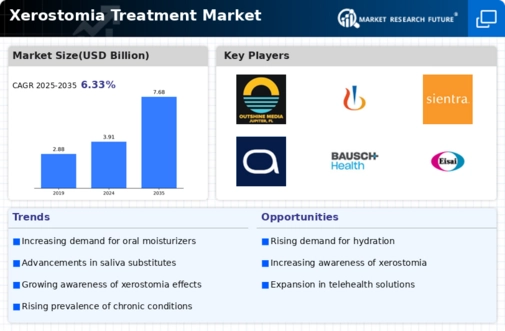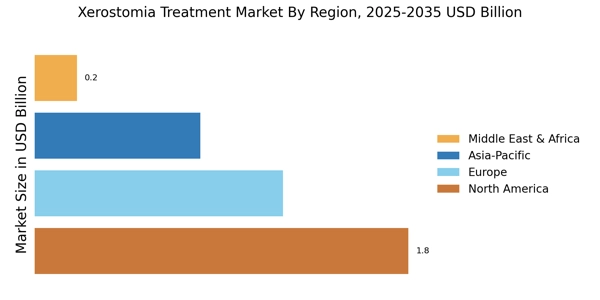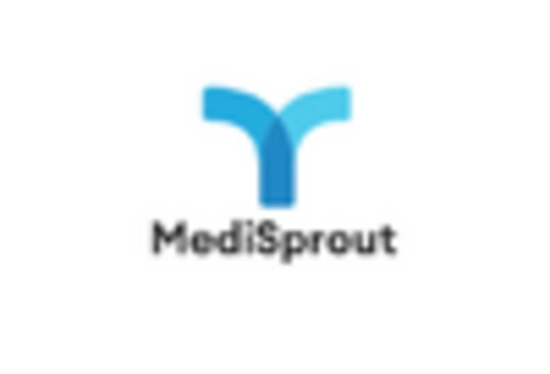Rising Incidence of Chronic Diseases
The rising incidence of chronic diseases is another critical driver influencing the Xerostomia Treatment Market. Conditions such as diabetes, hypertension, and autoimmune disorders often lead to xerostomia as a side effect of the medications used to manage these diseases. For instance, studies indicate that nearly 40% of individuals with diabetes report experiencing dry mouth, which underscores the need for effective treatment options. As the prevalence of these chronic conditions continues to escalate, the demand for xerostomia treatments is expected to grow correspondingly. This trend compels healthcare providers and pharmaceutical companies to prioritize the development of new therapies and products that address the specific needs of patients suffering from xerostomia due to chronic illnesses. The Xerostomia Treatment Market is thus poised for expansion as it adapts to the evolving healthcare landscape.
Advancements in Treatment Technologies
Advancements in treatment technologies are significantly shaping the Xerostomia Treatment Market. Innovations such as saliva substitutes, oral moisturizers, and prescription medications have emerged as effective solutions for managing xerostomia. The introduction of novel drug delivery systems and biotechnological advancements has enhanced the efficacy of these treatments, making them more appealing to both patients and healthcare providers. Furthermore, the integration of digital health technologies, such as mobile applications for symptom tracking and telehealth consultations, is likely to improve patient engagement and adherence to treatment regimens. As these technologies continue to evolve, they may lead to the development of more personalized and effective treatment options for xerostomia, thereby driving growth in the Xerostomia Treatment Market. The ongoing research and development efforts in this area suggest a promising future for innovative treatment solutions.
Regulatory Support for Xerostomia Treatments
Regulatory support for xerostomia treatments plays a crucial role in shaping the Xerostomia Treatment Market. Government agencies are increasingly recognizing the need for effective management of xerostomia, leading to streamlined approval processes for new therapies and products. This regulatory backing encourages pharmaceutical companies to invest in research and development, fostering innovation within the market. Moreover, the establishment of guidelines and recommendations for the treatment of xerostomia by health authorities further legitimizes the condition and emphasizes the importance of effective management strategies. As a result, the Xerostomia Treatment Market is likely to experience accelerated growth, driven by the introduction of new and improved treatment options that meet regulatory standards. This supportive environment may also enhance patient access to necessary therapies, ultimately improving health outcomes.
Increased Awareness and Education on Xerostomia
Increased awareness and education regarding xerostomia are vital drivers for the Xerostomia Treatment Market. Healthcare professionals and patients alike are becoming more informed about the implications of dry mouth, leading to a greater demand for effective treatment options. Educational initiatives aimed at both healthcare providers and the general public have been instrumental in highlighting the importance of addressing xerostomia, particularly in relation to oral health and overall well-being. As awareness grows, patients are more likely to seek treatment, thereby expanding the market for xerostomia therapies. Additionally, healthcare providers are increasingly recognizing the need to incorporate xerostomia management into their practice, further propelling the growth of the Xerostomia Treatment Market. This trend indicates a shift towards a more proactive approach in managing xerostomia, ultimately benefiting patients.
Aging Population and Xerostomia Treatment Market Demand
The increasing aging population is a pivotal driver for the Xerostomia Treatment Market. As individuals age, the prevalence of xerostomia, or dry mouth, tends to rise due to various factors such as medication side effects and age-related health conditions. It is estimated that approximately 30% of older adults experience some form of dry mouth, which significantly boosts the demand for effective treatment options. This demographic shift necessitates a greater focus on developing innovative therapies and products tailored to the needs of older patients. Consequently, pharmaceutical companies and healthcare providers are likely to invest more resources into research and development, thereby expanding the Xerostomia Treatment Market. The growing recognition of xerostomia as a serious health concern among the elderly further emphasizes the need for targeted solutions.


















Leave a Comment